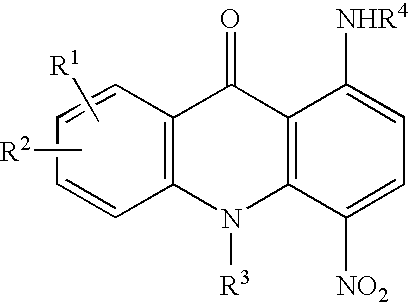Amyloid beta protein (globular assembly and uses thereof)
- Summary
- Abstract
- Description
- Claims
- Application Information
AI Technical Summary
Problems solved by technology
Method used
Image
Examples
example 1
Preparation of Amyloid β Oligomers
[0153] According to the invention, ADDLs were prepared by dissolving 1 mg of solid amyloid β 1-42 (e.g., synthesized as described in Lambert et al., J. Neurosci. Res., 39, 377-395, 1994) in 44 μL of anhydrous DMSO. This 5 mM solution then was diluted into cold (4° C.) F12 media (Gibco BRL, Life Technologies) to a total volume of 2.20 mL (50-fold dilution), and vortexed for about 30 seconds. The mixture was allowed to incubate at from about 0° C. to about 8° C. for about 24 hours, followed by centrifugation at 14,000 g for about 10 minutes at about 4° C. The supernatant was diluted by factors of 1:10 to 1:10,000 into the particular defined medium, prior to incubation with brain slice cultures, cell cultures or binding protein preparations. In general, however, ADDLs were formed at a concentration of Aβ protein of 100 μM. Typically, the highest concentration used for experiments is 10 μM and, in some cases, ADDLs (measured as initial Aβ concentration...
example 2
Crosslinking of Amyloid β Oligomers
[0155] Glutaraldehyde has been successfully used in a variety of biochemical systems. Glutaraldehyde tends to crosslink proteins that are directly in contact, as opposed to nonspecific reaction with high concentrations of monomeric protein. In this example, glutaraldehyde-commanded crosslinking of amyloid β was investigated.
[0156] Oligomer preparation was carried out as described in example 1, with use of substitute F12 media. The supernatant that was obtained following centrifugation (and in some cases, fractionation) was treated with 0.22 mL of a 25% aqueous solution of glutaraldehyde (Aldrich), followed by 0.67 mL of 0.175 M sodium borohydride in 0.1 M NaOH (according to the method of Levine, Neurobiology of Aging, 1995). The mixture was stirred at 4° C. for 15 minutes and was quenched by addition of 1.67 mL of 20% aqueous sucrose. The mixture was concentrated 5 fold on a SpeedVac and dialyzed to remove components smaller than 1 kD. The materi...
example 3
Size Characterization of ADDLs
[0157] This example sets forth the size characterization of ADDLs formed as in Example 1, and using a variety of methods (e.g., native gel electophoresis, SDS-polyacrylamide gel electrophoresis, AFM, field flow fractionation, and immunorecognition).
[0158] AFM was carried out essentially as described previously (e.g., Stine et al., J. Protein Chem., 15, 193-203, 1996). Namely, images were obtained using a Digital Instruments (Santa Barbara, Calif.) Nanoscope IIIa Multimode Atomic force microscope using a J-scanner with xy range of 150μ. Tapping Mode was employed for all images using etched silicon TESP Nanoprobes (Digital Instruments). AFM data is analyzed using the Nanoscope IIIa software and the IGOR Pro™ waveform analysis software. For AFM analysis, 4μ scans (i.e., assessment of a 4 μm×4 μm square) were conducted. Dimensions reported herein were obtained by section analysis, and where width analysis was employed, it is specified as being a value obt...
PUM
| Property | Measurement | Unit |
|---|---|---|
| temperature | aaaaa | aaaaa |
| size | aaaaa | aaaaa |
| size | aaaaa | aaaaa |
Abstract
Description
Claims
Application Information
 Login to View More
Login to View More - R&D
- Intellectual Property
- Life Sciences
- Materials
- Tech Scout
- Unparalleled Data Quality
- Higher Quality Content
- 60% Fewer Hallucinations
Browse by: Latest US Patents, China's latest patents, Technical Efficacy Thesaurus, Application Domain, Technology Topic, Popular Technical Reports.
© 2025 PatSnap. All rights reserved.Legal|Privacy policy|Modern Slavery Act Transparency Statement|Sitemap|About US| Contact US: help@patsnap.com



